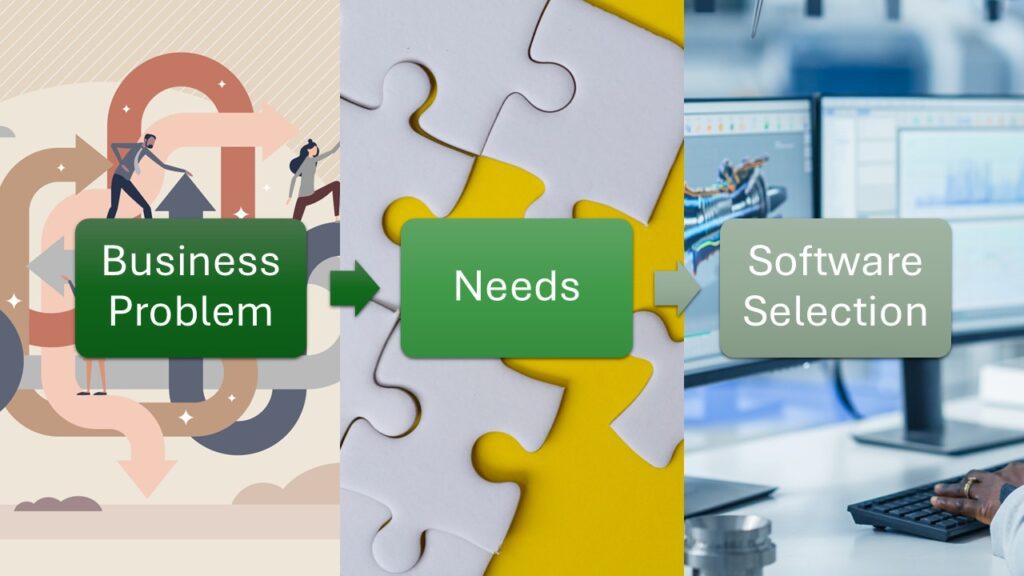Scaling your business is exciting, but it also comes with the risk of making decisions that could slow growth rather than support it.
One of the most common pitfalls? Choosing the wrong software.
From CRMs to ERPs to AI-enhanced platforms, it’s tempting to think the latest tool will solve your problems. But to effectively scale, you need more than software. You need clarity. And that starts with strategy.
This quick 5-step guide will help you cut through the noise, choose the right software, and avoid tech debt while setting your business up for long-term success.

Required Tools & Prerequisites
Before we dive into the 5-step guide on how to select the proper tech tools when scaling your business, here is a list of the things you need for successful completion of the selection process:
- A clear understanding of your business goals (quarterly to 3-year horizon)
- Involvement from your leadership team (or your whole team, depending on how big your company is)
- Time for a structured decision-making process (Discovery Engagement recommended)
Now that you have the required prerequisite, let’s start the journey.
Step 1: Anchor the Software Decision in Business Strategy
Don’t start with the tool. Start with the outcome.
Before you look at features, get alignment on the specific business problems you’re solving.
Some questions that can help you with identifying the business need:
- What key bottlenecks are slowing us down?
- What are our non-negotiable outcomes over the next 12–24 months?
- What kind of scale are we building toward?
Remember, technology is only a tool. Business goals, needs, and processes come first.

Step 2: Identify What Needs to Be Centralized vs. Decentralized
Jores Minasvand framed this perfectly: “The mistake is trying to centralize things that shouldn’t be, and not centralizing what should.”
To choose the right software, decide:
- What workflows need consistent, centralized data?
- What areas of the business benefit from autonomy and flexibility?
This step informs whether you need a unified platform (one software across teams and functions) or modular tools that integrate well.
Trusted Advisor Tip: A single source of truth (like your CRM or customer data) should rarely be compromised.
Step 3: Score Tools Based on Fit, Not Features
Avoid the feature trap. You need a tool that fits how your business works (or aspires to work).
Create a simple evaluation grid:
- Alignment with process
- Ease of implementation
- Scalability
- User adoption risk
- Integration with existing systems
Once you have this grid, evaluate each software option using a scoring approach (e.g., score 1 to 5 where 5 is 100% fit and 1 is 0% fit).
This data-driven approach can help you choose the right software with the highest score (which would be most aligned, easiest to implement, and with the lowest adoption risk).
Step 4: Avoid the “Reactive Tool Grab”
When scaling, teams often buy tools reactively to fix the pain of the day. But this leads to disjointed systems and operational drag.
Instead:
- Resist buying software because of a cool demo or peer pressure.
- Build in a 72-hour pause before any purchase decision.
- Use a Discovery Engagement to map out future needs and coordinate decisions across departments.
Featured Service: Thrive360 Business Solutions Discovery Engagement by Leficomp helps companies identify the right systems based on strategic, operational, and leadership alignment (not software hype).

Step 5: Plan the Adoption Path Before You Buy
Implementation is often where good tools go to die. Even if you choose the right software, you still need to make sure you implement it properly.
Before signing the contract:
- Define ownership: Who will champion the rollout?
- Define the first 30, 60, and 90 days of implementation and use.
- Plan training and success metrics.
“You don’t have a software problem. You have a clarity and coordination problem. Software just exposes it.” Jores Minasvand
Common Mistakes to Avoid
In addition to the 5-step process above, be aware of the following mistakes many businesses make:
- Choosing software without involving cross-functional leaders
- Centralizing for control instead of efficiency
- Ignoring long-term maintenance costs
- Assuming users will “just figure it out”
Make Tech Decisions That Accelerate, Not Hinder Growth
Selecting software during a scale phase is high stakes. Done poorly, it leads to operational friction and frustrated teams. Done right, it sets the foundation for high-leverage growth.
The key? Don’t lead with the tech. Lead with the business need and coordinate decisions across leadership.
Leficomp’s Thrive360 Business Solutions Discovery Engagement is designed for exactly this purpose. We guide you through strategic alignment, system needs analysis, and help you build a roadmap that supports sustainable scaling.
Curious if your team is aligned and your systems are scale-ready? Book a Consultation Call today and avoid expensive mistakes down the road.






